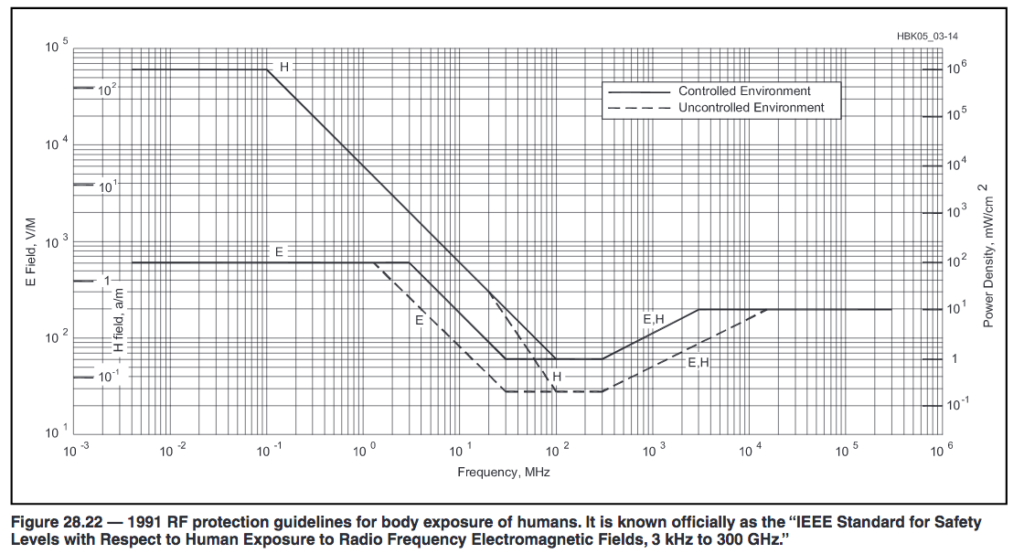RF exposure station assessment
last updated 15 December 2025.
The Federal Communications Commission (FCC) now requires all ham stations in the USA and possessions to be evaluated for RF exposure, effective May 2023. Before that, many ham stations were exempt from running the calculations if they ran less than a minimum power. Ham stations running 100W on HF (except 50W on 10m) did not need to do any further analysis. Other limits applied at MF, VHF, etc.
The exposure limits haven’t changed, but a new uniform set of calculations has been implemented for all radio services. Hams are required to perform the exposure calculations for different bands and antennas that they use, and maintain a record in the station logbook.

The actual exposure guidelines vary with frequency, and at HF are different for the E and H field. (This plot is from the ARRL materials.) Fortunately, you don’t need to refer to it in most cases.
There are two steps to the procedure. First, determine whether the expected exposure distance is within the near field, defined as 0.16 wavelength from the closest point of the antenna. If it is further than that, then the ARRL has a convenient calculator where you just enter the numbers and record the allowable exposure distances.
Basically, for a given power level in a particular antenna, there are two distance limits. The “controlled” distance is for the station operator and others under their control, who are aware of the hazard. The “uncontrolled” distance is for passersby or others of the general public who aren’t aware when the station is transmitting. If people can violate either limit, then you can experiment with different power levels to see what is safe given the expected exposure distances.
Most commonly, the full transmitter power is assumed, along with the peak gain of the antenna. This gives a conservative result. Often that will show that there is no exposure issue. Otherwise the power can be averaged based on the mode and duty cycle, and losses in the coax, ground, etc. can be used to reduce the power level used in the calculations. With a directional antenna, the gain in the direction of the potential exposure can be used if it is not in the main lobe. All of these reduce the expected exposure level, and they should be included in the documentation.
However, what often gets ignored is that case where exposure happens within the near field of the antenna. That corresponds to about 13m ( 45 feet ) on 80m and 6.5m ( 22 feet ) on 40m, where it is not uncommon for an antenna on a roof or in an attic to be closer than that. Another common condition is an antenna mounted on an HT, which is held right in front of the operator. Then things can get more complicated.
Ham HTs are exempt from the extensive testing for FCC type acceptance that is required for other services. K5UJU has collected data from public records of exposure tests on commercial radios operating in similar frequency ranges, and determined that the allowable (controlled) power limits for such use are 22 watts on 2m and 5 watts on 70cm with a “typical” HT antenna. Assuming that any bystanders are a reasonable distance from the operator, this study can be referenced in your notes. (Using a taller, higher gain antenna actually reduces the exposure, as more of the power is radiated at a greater distance from the head of the operator.)
That still leaves the question of low antennas for HF, especially on the lower frequency bands. So I ran a series of models of dipole antennas and examined the field strength of both the E and H fields at various distances from the antenna. (The ARRL materials explain how to do this.) My result is that, for a 100W SSB transmitter, a spacing of 1.5m ( 5 feet ) for controlled and 3m ( 10 feet ) for uncontrolled exposure is safe throughout the HF spectrum. The worst case is near the ends of the antenna on 10m: at the lower frequencies, much of the antenna will be further from the operator.
Now, this applies only to dipole antennas at a nominal height above ground, but that should handle a lot of cases with low wire antennas that are reasonably similar to a dipole, especially on the lower bands where there is a lot of safety margin. In many cases, those distances shouldn’t be difficult to obtain.
Note that other types of antennas, particularly small transmitting loops, can require much greater distances, due to stronger fields close to the antenna. The ARRL materials include some examples that may be helpful.
When searching for more information about RF Exposure evaluation online, make sure you check the date of any materials you find. The FCC rule change was made in 2021, and there are many older versions of documents available that are not up to date.
To simplify the process, I’ve created a calculation sheet (PDF) that you can print out (for each antenna and frequency), fill in, and put in your records.
BACK TO:
RELATED LINKS:
EXTERNAL LINKS:
ARRL Frequently Asked Questions about RF exposure evaluation